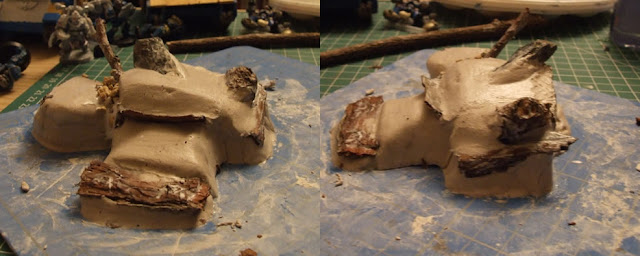Dun dun dun!
Back by unpopular demand - yes, I have returned. I spent ages not painting and therefore having no reason to blog. Now I've started again and actually have stuff to post!
Today we had an excellent trip to Hobbycraft to pick up some new supplies. I've been investigating weathering methods with oil paints. I managed to pick up a good bundle of stuff and when I have the camera working I'll get some good pics up.
Some of you with better memories than others may remember I bought all the miniature mentor videos a while back. I'd seen a few people use them in picture tutorials, or heard people talk about using them on a miniature they were presenting, but it wasn't until I actually watched the process on a tutorial as this guy weathered his dreadnought did I think 'Yeah, I want to do that'. Until then it had seemed like a pretty big deal to start: you'd need brushes, thinners, cleaners, paints etc. Really all I needed was the paints and some form of turpentine.

Because I'm not doing any actual oil painting, rather I'm smearing it all over some models rather indiscriminately, I don't need fancy new brushes or canvases or anything like that. I have some nice synthetic brushes - flats and filiberts - that I can do the work with. I picked up the Winton Oil Colour set by Winsor and Newton. It's described as their 'Moderately priced oil colours for beginners and amateur artists' and has 10 21ml tubes in. I didn't pick up any of the top range, superexpensive oil paints because I'm really not doing anything where it would show and I'm not good enough that it would make a visible difference. This particular set also had a nicer spread of colours than compared to the others; all the primaries, greens, browns, black and white. Most other sets all seemed to be '15 paints; 6 shades of yellow, 7 shades of brown, black and white - for all your ....' No, I can't think of a joke. I cannot think of anything that starting paint set would be geared towards.
 |
| Say it with a Spanish Accent. Sansador |
So that I can get my oil paints around on my models, out of my brush and probably out of my eye at some point I also grabbed some special turpentine. Oil paints aren't water soluble - water is polar, oils aren't polar. If they aren't the same they can't mix. Hydrocarbons - long chains of carbon with hydrogen sticking off them - aren't polar, and oil can mix in with them. Turpentine is just a certain length of hydrocarbon. It is very smelly though: this is due to hydrocarbons in the liquid that are shorter and so evaporate easily. I bought a special type referred to by Winsor and Newton as 'Sansador' that has had the shorter chains removed so it smells alot less. It's only a small bottle but it should last a long time. I will only be using tiny amounts at a time.
 |
| Smells like burning nostrils! |
There was something else I had been trying to find online but no physical store listed it as something they sold. I was so pleased when I saw it in Hobbycraft despite them claiming to not sell it. It is of course... humbrol maskol! It's a fluid you can apply to a model that dries to a tacky cover that you can paint over, and then peel off to reveal a patch of untouched original paint job. It's used in weathering or protecting small finished parts of a model. Also picked up some liquid poly by humbrol to use with my new....
 |
| Mmm entrails |
Squadron White Putty! Most of you would know the model already - this is Todd Swanson's 'Festus' model that won a Golden Demon and then the Slayer Sword the year it was entered. I watched his miniature mentor video on how he achieved the affect: diluting some putty to a semi-malleable consistency and then applying it to the edges of the miniature and roughly sculpting it with a scalpel. It creates a really nice...well, not nice. It creates a really good rusted or decaying effect depending on how you sculpt it. And if you dilute putty really far you can gently brush it over a model with a cotton bud or something to create a super smooth filled model.
Popping into Modelzone for putty was a mistake. One of the guys who works there mentioned there had been a huge miniatures thing here last weekend that we'd missed, and loads of random hard-to-get-in-england stuff had been there. There had even been a Mr Hobby section! On the plus side they had humbrol polycement with the funny long spout. I picked one up so I look like a proper modeler rather than one who swears and sprays gamesworkshop superglue everywhere.
Here's a generic tip: branded super glue is just marked up cyanoacrylate. Look for any generic thing called that and you have the same glue - for much less!
Here's a pro tip: Don't sniff humbrol maskol. Big old whiff of ammonia there, I actually need to go sit down.
Next post should be up on monday when I'm in front of my painting stuff at uni!













































